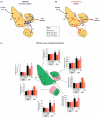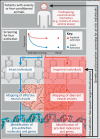Individual differences in recovery from traumatic fear
- PMID: 23260015
- PMCID: PMC3787595
- DOI: 10.1016/j.tins.2012.11.003
Individual differences in recovery from traumatic fear
Abstract
Although exposure to major psychological trauma is unfortunately common, risk for related neuropsychiatric conditions, such as post-traumatic stress disorder (PTSD), varies greatly among individuals. Fear extinction offers a tractable and translatable behavioral readout of individual differences in learned recovery from trauma. Studies in rodent substrains and subpopulations are providing new insights into neural system dysfunctions associated with impaired fear extinction. Rapid progress is also being made in identifying key molecular circuits, epigenetic mechanisms, and gene variants associated with differences in fear extinction. Here, we discuss how this research is informing understanding of the etiology and pathophysiology of individual differences in risk for trauma-related anxiety disorders, and how future work can help identify novel diagnostic biomarkers and pharmacotherapeutics for these disorders.
Published by Elsevier Ltd.
Figures



Similar articles
-
Rodent models of impaired fear extinction.Psychopharmacology (Berl). 2019 Jan;236(1):21-32. doi: 10.1007/s00213-018-5054-x. Epub 2018 Oct 31. Psychopharmacology (Berl). 2019. PMID: 30377749 Free PMC article. Review.
-
Effects of vagus nerve stimulation on extinction of conditioned fear and post-traumatic stress disorder symptoms in rats.Transl Psychiatry. 2017 Aug 22;7(8):e1217. doi: 10.1038/tp.2017.191. Transl Psychiatry. 2017. PMID: 28892066 Free PMC article.
-
Behavioral interventions to eliminate fear responses.Sci China Life Sci. 2018 Jun;61(6):625-632. doi: 10.1007/s11427-018-9294-4. Epub 2018 May 7. Sci China Life Sci. 2018. PMID: 29744783 Review.
-
Stress and Fear Extinction.Neuropsychopharmacology. 2016 Jan;41(1):58-79. doi: 10.1038/npp.2015.180. Epub 2015 Jun 24. Neuropsychopharmacology. 2016. PMID: 26105142 Free PMC article. Review.
-
Attention bias toward threat is associated with exaggerated fear expression and impaired extinction in PTSD.Psychol Med. 2012 Mar;42(3):533-43. doi: 10.1017/S0033291711001565. Epub 2011 Aug 22. Psychol Med. 2012. PMID: 21854700 Free PMC article.
Cited by
-
PTSD: Past, present and future implications for China.Chin J Traumatol. 2021 Jul;24(4):187-208. doi: 10.1016/j.cjtee.2021.04.011. Epub 2021 Apr 26. Chin J Traumatol. 2021. PMID: 33994278 Free PMC article. Review.
-
Tempering aversive/traumatic memories with cannabinoids: a review of evidence from animal and human studies.Psychopharmacology (Berl). 2019 Jan;236(1):201-226. doi: 10.1007/s00213-018-5127-x. Epub 2019 Jan 2. Psychopharmacology (Berl). 2019. PMID: 30604182 Review.
-
Preclinical studies of stress, extinction, and prefrontal cortex: intriguing leads and pressing questions.Psychopharmacology (Berl). 2019 Jan;236(1):59-72. doi: 10.1007/s00213-018-5023-4. Epub 2018 Sep 17. Psychopharmacology (Berl). 2019. PMID: 30225660 Free PMC article. Review.
-
Emergence in extinction of enhanced and persistent responding to ambiguous aversive cues is associated with high MAOA activity in the prelimbic cortex.Neurobiol Stress. 2016 Aug 31;5:1-7. doi: 10.1016/j.ynstr.2016.08.005. eCollection 2016 Dec. Neurobiol Stress. 2016. PMID: 27981191 Free PMC article.
-
Making translation work: Harmonizing cross-species methodology in the behavioural neuroscience of Pavlovian fear conditioning.Neurosci Biobehav Rev. 2019 Dec;107:329-345. doi: 10.1016/j.neubiorev.2019.09.020. Epub 2019 Sep 12. Neurosci Biobehav Rev. 2019. PMID: 31521698 Free PMC article. Review.
References
-
- American Psychiatric Association . Diagnostic and Statistical Manual of Mental Disorders. 4th APA Press; 1994.
-
- Breslau N, Kessler RC. The stressor criterion in DSM-IV posttraumatic stress disorder: an empirical investigation. Biol. Psychiatry. 2001;50:699–704. - PubMed
-
- Lissek S, et al. Classical fear conditioning in the anxiety disorders: a meta-analysis. Behav. Res. Ther. 2005;43:1391–1424. - PubMed
Publication types
MeSH terms
Grants and funding
LinkOut - more resources
Full Text Sources
Other Literature Sources
Medical

